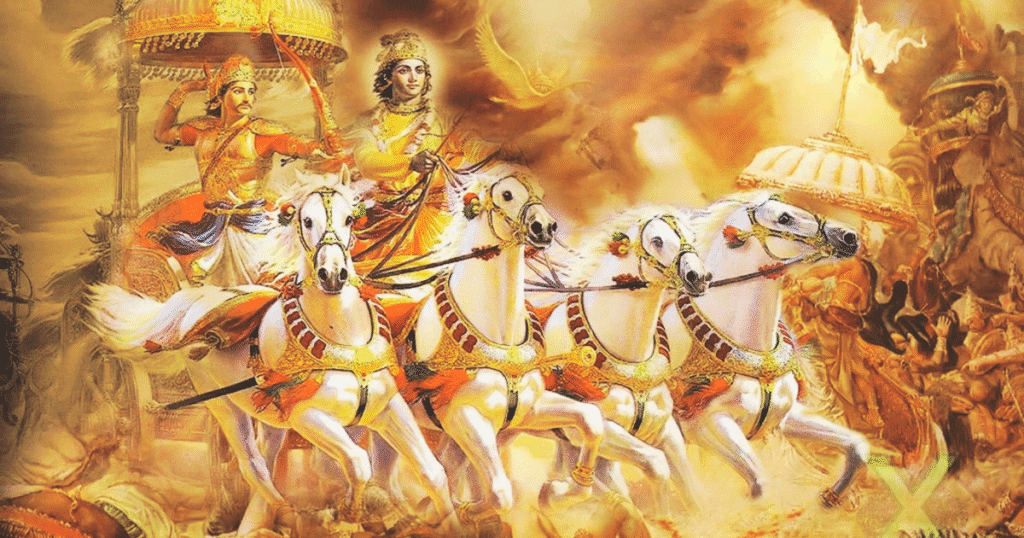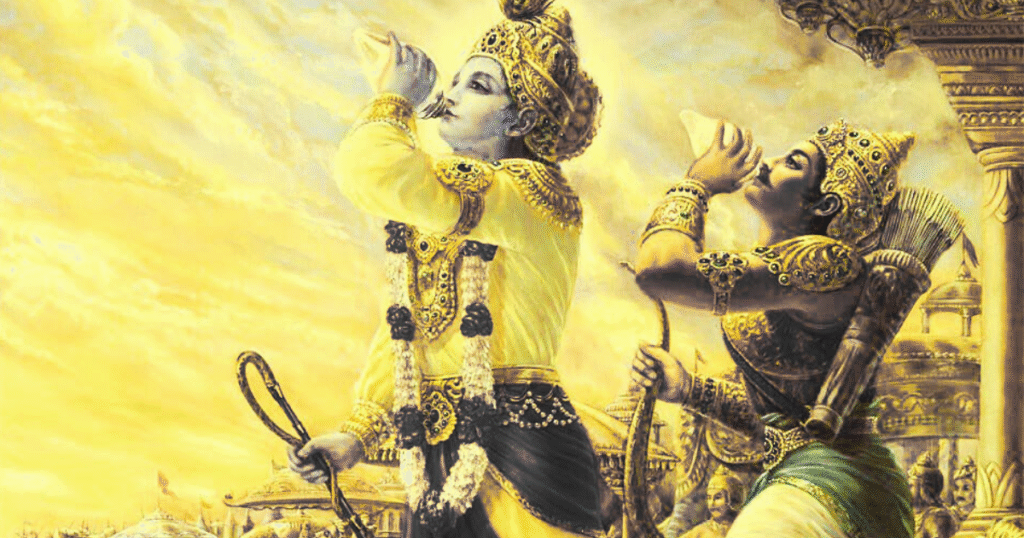Introdution
Bhishma Parva is the sixth chapter of the Mahabharata, and is one of the most decisive sections of the Hindu religious text Mahabharata. This chapter marks the actual beginning of the Kurukshetra War. This chapter is the 117th chapter (from chapter numbers 23 to 139). Bhishma Parva is named after the great warrior Bhishma Pitamah of the Mahabharata, who leads the war as a commander on the Kaurava side.
first shloka of Mahabharata Bhishma Parva

There is a collection of one lakh verses in the Shrimad Bhagwat Geeta. But one of the chapters is Bhishma Parva, which has 5,800+ verses. Geeta is part of this. What is the first verse of the Mahabharata Bhishma Parva? Let us know the verse and its meaning.
dharma-kṣetre kuru-kṣetre samavetā yuyutsavaḥ
māmakāḥ pāṇḍavāścaiva kimakurvata sañjayaधर्मक्षेत्रे कुरुक्षेत्रे समवेता युयुत्सवः
मामकाः पाण्डवश्चैव किमकुर्वत संजय।Dhritarash asked
“O Sanjay! What did my sons and the sons of Pandu, who desired war, gather at Dharmakshetra, Kurukshetra, and do?”
meaning :
Ignorance resides in the recesses of the mind. Dhritarashtra’s mind, covered with ignorance, is Janamandha;
But through Sanjaya, who is the embodiment of self-restraint, he has seen, heard, and understood that God is the only truth, yet as long as Duryodhan, who is born from him in the form of attachment, is alive, his eyes are always on the Kauravas.
Relate this verse of Gita to your life. The body is a field. When there is abundance of divine wealth in the heart, then this body becomes a field of religion and when there is abundance of demonic wealth in it, then this body becomes Kurukshetra.
Kuru means do. This word is imperative. Shri Krishna says that man performs work under the influence of the three qualities born from nature. He cannot stay without performing work even for a moment. Nature makes him do it. Work never stops. That too is just the essential food for a healthy body. The three qualities bind man in the bodies of gods to insects. As long as nature and the qualities born from nature are alive, Kuru will continue. Hence, the area of birth and death, the area of vices, is Kurukshetra, and the area of virtuous tendencies (Pandavas) that take one to the supreme religion, the Supreme Being, is Dharmakshetra.
Where was the battle of Kurukshetra
Archaeologists are engaged in researching Kurukshetra to find out where the war took place, but the author of the Gita himself has told us where the true battlefield lies.
“Idam śarīram kaunteya kṣetram ity abhidhīyate”
” इदं शरीरं कौन्तेय क्षेत्रमित्यभिधियते “
This body itself is the field, and one who knows it can transcend it. He further explained this field in detail, including the ten senses, the mind, intellect, ego, the five disorders, and the three gunas (qualities). The body is the arena. Two types of tendencies constantly battle within: divine qualities (Devi Sampada) and demonic qualities (Asuri Sampada). The ‘sons of Pandu’ and the ‘sons of Dhritarashtra’ represent these conflicting forces within us.”

what is bhishma parva
Bhishma Parva is the sixth chapter of the Mahabharata. In which the Kurukshetra war begins. In this war, the Pandavas stand face to face on one side and the Kauravas on the other side. At this time, the real battle of Dharma and Adharma begins.
Arjuna becomes attached to his brothers standing in Kurukshetra, he refuses to fight. To remove Arjuna’s attachment, Lord Shri Krishna preaches to him the Bhagwat Geeta, then Arjuna gets ready for the war. Commander Bhishma Pitamah stays on the Kaurava side for the first 10 days. That is why this festival is named Bhishma Parva after Bhishma Pitamah, a disciple of the great warrior Parashurama.
What is the role of Bhishma in Mahabharata
Gangaputra Devvrat was a great warrior of Mahabharata. Bhishma was not only a great warrior but he is also considered a symbol of Dharma, ethics and sacrifice. He had given up lifelong celibacy and throne for the happiness of his father. This was his Bhishma Pratigya and he also protected the Kuru clan. After this he was the state moral guardian of Hastinapur, he always served Hastinapur, even at the time of injustice like disrobing of Draupadi, he remained bound by his valor and pledge.
how many days Bhishma fought in Mahabharata War
Bhishma fought for 10 days on the side of the Kauravas in Kurukshetra. Bhishma was the commander of the war from the first day to the 10th day. He used to kill 50,000 to 1 lakh charioteers, elephants, horsemen, and infantrymen every day. Arjun brings Shikhandi on his chariot and kills Bhishma.
Bhishma did not attack any woman or unarmed person; that is why Arjun lays him on a bed of arrows. It is said that he fought for 10 days, but he was alive for more than 58 days before his death on the battlefield. In his last moments, he preached Rajdharma, Niti, and Dharmashastra to Yudhishthira, and then, by giving up his life by willful death, he went to heaven.
how many shlokas in mahabharata
The Numberof shlokas in Bhishma Parva is 5884 and Mahabharata has a total of about 1 lakh verses and is divided into 18 parts. It was composed by Maharishi Ved Vyas. It is about four times larger than Ramayana and is considered the world’s largest epic. It begins with Adi Parva and ends with Swargarohan Parva in which Yudhishthira ascends to heaven.